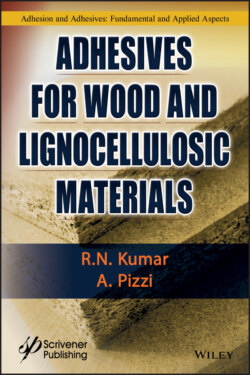Читать книгу Adhesives for Wood and Lignocellulosic Materials - R. N. Kumar - Страница 18
1.3.1.2 Wood Cells
ОглавлениеA living plant cell consists of two primary domains: the protoplast and the cell wall. The protoplast is the sum of the living contents that are bounded by the cell membrane. The cell wall is a non-living, largely carbohydrate matrix extruded by the protoplast to the exterior of the cell membrane. The plant cell wall protects the protoplast from osmotic lysis and often provides mechanical support to the plant at large [9, 10].
In wood, the ultimate function of the cell is borne solely by the cell wall. This means that many mature wood cells not only do not require their protoplasts, but indeed must completely remove their protoplasts prior to achieving functional maturity. For this reason, a common convention in wood literature is to refer to a cell wall without a protoplast as a cell. Although this is technically incorrect from a cell biological standpoint, this convention is common in the literature [6].
In the case of a mature cell in wood in which there is no protoplast, the open portion of the cell where the protoplast would have existed is known as the lumen (plural: lumina). Thus, in the wood cells, there are two domains: the cell wall and the lumen.
Wood cells are microscopic, long, thin, hollow tubes, like soda straws with their ends pinched shut. Most longitudinal cells that are parallel to the longitudinal axis or grain direction of the tree trunk are meant either for support or for the movement of fluids in the living tree. Some special cells are organized into tissue called rays that lie perpendicular to the longitudinal axis of the tree trunk and along its radii. Ray cells are responsible for the production and storage of amorphous materials of complex chemical nature. The rays are also the pathway for lateral movement of fluids in the tree [5].
There are two basic types of cells—prosenchyma and parenchyma. Softwoods and hardwoods have different types of prosenchyma and parenchyma cells. Prosenchyma cells are generally the strong woody cells responsible for mechanical support and the movement of fluids in the living tree. Parenchyma cells are responsible for the production of chemicals and for the movement and storage of food. The real differences between softwoods and hardwoods are in the size, shape, and diversity of these two types of cells [5].
The structure of softwoods is characterized by relatively few types of prosenchyma and parenchyma cells compared to hardwoods as a result of their lower position on the evolutionary scale. One type of prosenchyma cell, the longitudinal tracheid, constitutes approximately 90–94% of the volume of softwood wood. Tracheids perform both the support and fluid movement for the tree. Earlywood tracheids are generally of large diameter and thin walled. Earlywood cells are specifically adapted to moving fluids through large openings (bordered pits) that connect adjoining cells. Latewood tracheids, which are generally smaller in diameter, are thicker walled, have smaller pits, and are specifically adapted for strength. The remaining 10% of softwood consists of longitudinal parenchyma cells, ray tracheids, and ray parenchyma cells. Generally, parenchyma cells play a secondary strength role, but they are important for adhesive bonding as paths for adhesive penetration. Moreover, the chemicals contained by the cells affect adhesion and adhesive cure.
In comparison to softwoods, the structure of hardwoods is characterized by a greater diversity of cell types and functions. One notable difference is that one type of specialized prosenchyma cells is responsible for mechanical support, and another type of specialized prosenchyma cells is responsible for fluids movement. Support is provided by two types of small-diameter thick-walled prosenchyma cells called libriform fibers and fiber tracheids. Fluid movement is provided by medium- to large-diameter, thin-walled, and open-ended cells called vessel elements. Normally, a number of vessel elements link end to end along the grain to form long tube-like structures known as vessels. The cavities are large enough to see with the naked eye. Such large cavities obviously affect wood strength and adhesive flow when pressure is applied during bonding. The longitudinally oriented fibers and vessels together constitute the major volume of cells (roughly 70–90%) in hardwoods. A number of other specialized longitudinal prosenchyma and parenchyma cells and ray prosenchyma and parenchyma cells constitute the remaining volume. As in the softwoods, some of these minor hardwood cell types have important chemical roles and secondary, though often minor, mechanical roles.
